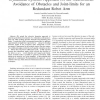Free Online Productivity Tools
i2Speak
i2Symbol
i2OCR
iTex2Img
iWeb2Print
iWeb2Shot
i2Type
iPdf2Split
iPdf2Merge
i2Bopomofo
i2Arabic
i2Style
i2Image
i2PDF
iLatex2Rtf
Sci2ools
IROS
2006
IEEE
2006
IEEE
Dynamical Systems Approach for the Autonomous Avoidance of Obstacles and Joint-limits for an Redundant Robot Arm
— We extend the attractor dynamics approach to generate goal-directed movement of a redundant, anthropomorphic arm while avoiding dynamic obstacles and respecting joint limits. To make the robot’s movements human-like, we generate approximately straight-line trajectories by using two heading direction angles of the tool-point quite analogously to how movement is represented in the primate central nervous system. Two additional angles control the tool’s spatial orientation so that it follows the tool-point’s collision-free path. A fifth equation governs the redundancy angle, which controls the elevation of the elbow so as to avoid obstacles and respect joint limits. These variables make it possible to generate movement while sitting in an attractor (or, in the langauge of the potential field approach, in a minimum). We demonstrate the approach on an assistant robot [1], which interacts with human users in a shared workspace.
Related Content
| Added | 12 Jun 2010 |
| Updated | 12 Jun 2010 |
| Type | Conference |
| Year | 2006 |
| Where | IROS |
| Authors | Ioannis Iossifidis, Gregor Schöner |
Comments (0)

